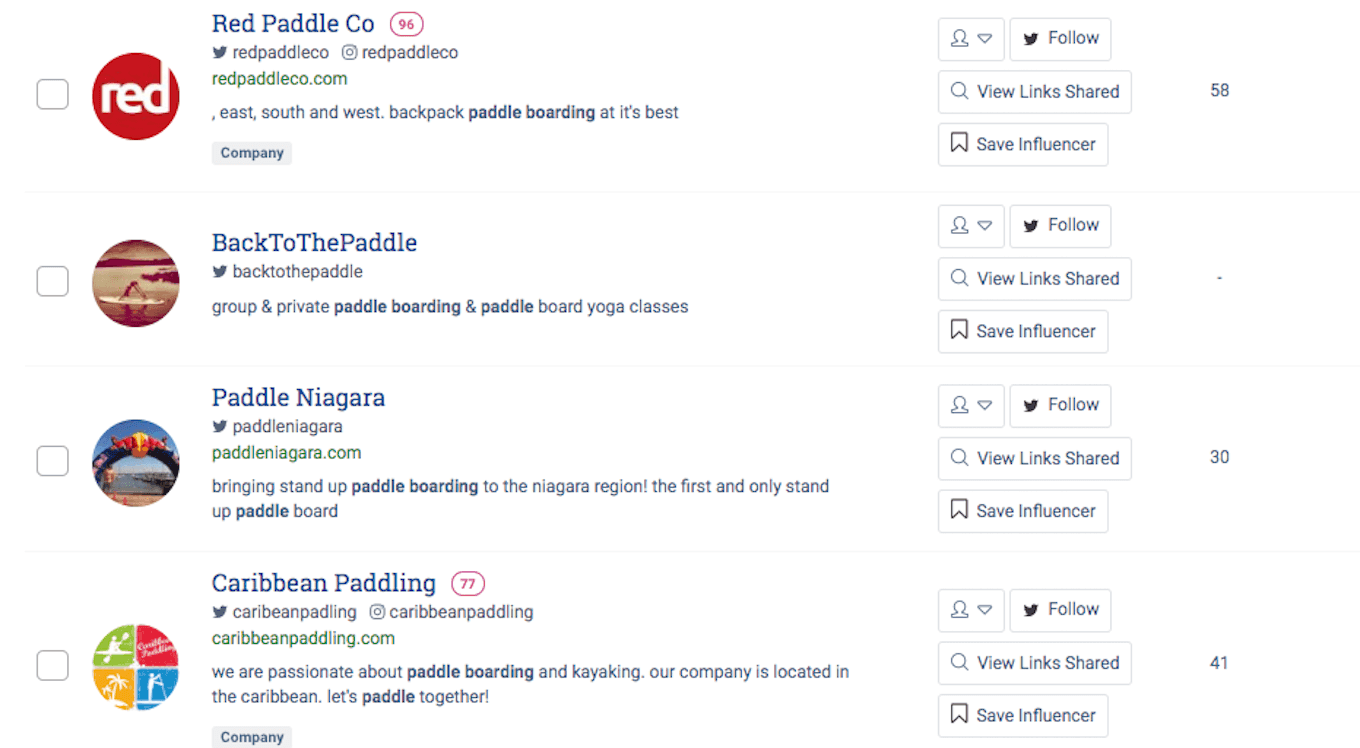So your boss has come to you and said you need to do a competitive analysis. Perhaps you’re looking for a competitive analysis example to guide you, whether you’ve never conducted one before or it’s been a while since your last assessment. Maybe you need to brush up on your skills before diving into another one.
Either way, we’ve got your back.
By the end of this post, you’re going to…
- Learn what a competitive analysis is (and why you should care)
- Easily be able to conduct your own competitive analysis (because I’m breaking it down into three easy steps)
- Get an example of what a competitive analysis looks like (for easy reference later)
- AND be able to download your very own competitive analysis template down below.
[guide_content_upgrade_shortcode]
Let’s get to it.
What Is A Competitive Analysis?
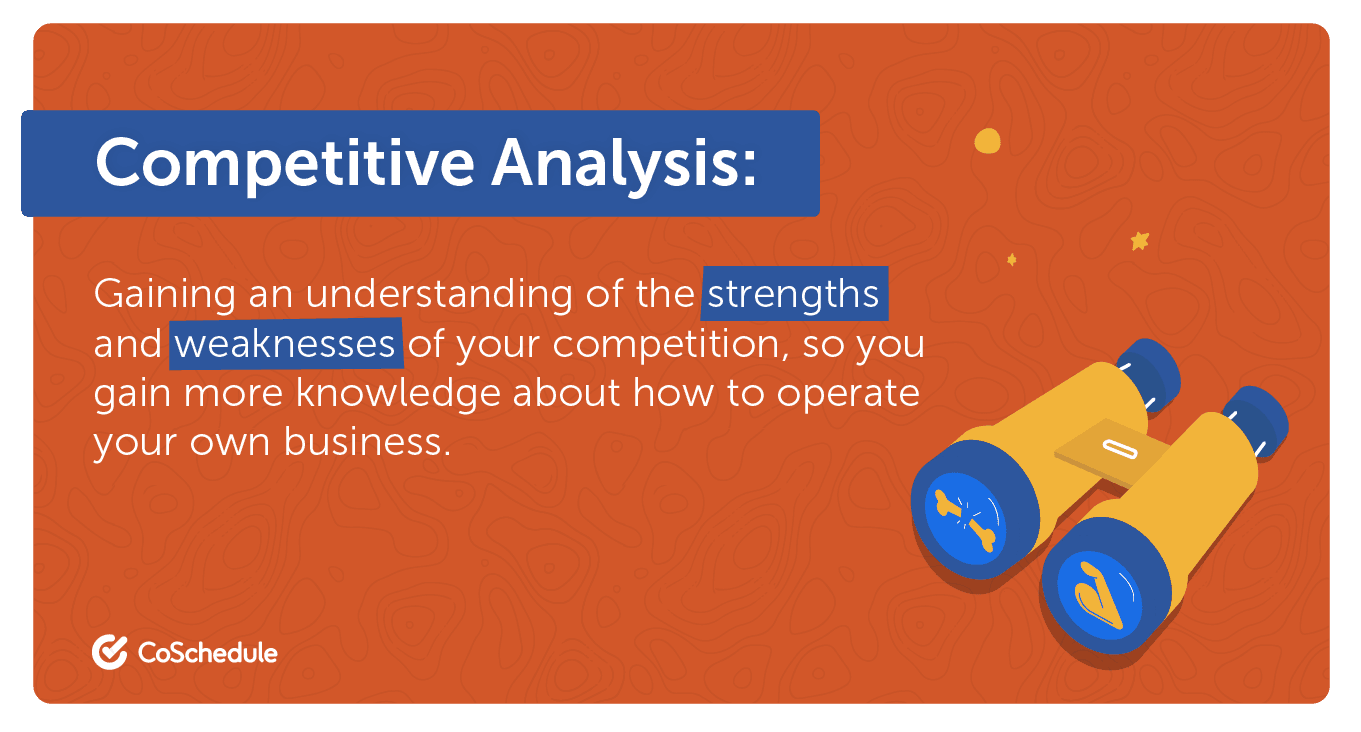
If you’ve never done a competitive analysis before, this is a good place to start.
Every business that I know of has competitors.
(This isn’t just for the Nike’s of the world, because the smaller you are, the more vulnerable you are to the competition.)
Understanding the strengths and weaknesses of your competition is important to the success of your business. Besides better understanding the environment your business operates in, conducting regular competitive analyses also helps you:
- Understand how you can improve your own promotional tactics…
- Forecast the future of the market (especially related to the economic climate)…
- Better target current customers…
AND helps you read new audiences.
Said another way – conducting a competitor analysis is crucial to how you decide to operate your entire business.
Competitive Analysis Definition
According to Entrepreneur, the competitive analysis definition is this:
“Identifying your competitors and evaluating their strategies to determine their strengths and weaknesses relative to those of your own product or service.”
Competitor analyses are more complex than just figuring out what your competitors are (or are not doing). They’re about taking what you learn and improving your own business. After all, data that doesn’t drive change is just a number.
So without further ado…
Let’s jump into how to do a competitor analysis!
How To Do A Competitive Analysis
Performing a competitive analysis might seem like just another task on your ever-increasing to-do list. And, while it might seem daunting at first, they’re not that complicated and they are really beneficial.
And to prove it – I’ve broken down how to do a competitive analysis in THREE (yes, just three) easy steps.
Step 1: Identify Your Competitors
This is an obvious first step in conducting a Competitive Analysis.
Start by Googling the products or services your business offers and noting the results. This helps identify your actual competitors—the businesses that sell similar products or services and directly impact your success.
For example, if you sell camping gear, you’d search for “camping tents, lanterns, camping equipment” and list companies offering similar products. A local women’s boutique competes with other women’s clothing stores, not the men’s retailer across the street. Likewise, a Minneapolis marketing agency should focus on comparable local firms, not a global agency like Ogilvy. Identifying the right competitors ensures your analysis is relevant and actionable.
Step 2: Research Your Competitors
Once you’ve identified your competitors, it’s time to research them! This step takes the most time but is the most important. Focus first on their business details, including pricing strategies, sales format (online or in-store), and product positioning.
Next, determine why customers choose your business over competitors. The best way is through a customer survey. Ask questions like:
- Which businesses did you consider before choosing us?
- What do we offer that competitors don’t?
- What do competitors have that you wish we did?
Honest feedback helps you understand how you compare to competitors.
Next, analyze their marketing—website, social media, and emails—to gain deeper insights.
Here are the major things you need to consider:
- What are they doing with their marketing content?
- What are their overall strategies when it comes to demand generation, PR / social media, and product marketing?
- Who is their target audience? (I.e. Young professionals? College students? Professional marketers?)
- How many followers do they have on all the social networks?
- How are they positioning themselves in the market? (I.e. Are they the highest / lowest $$$ option?)
This research can help you understand weaknesses in your own strategy which can give you actionable insights.
Step 3: Compare Your Business
The last step is to compare yourself with your competitors.
The best way to do this is by performing a SWOT analysis for each competitor, which helps you identify your own strengths and weaknesses, and in turn, identify your future opportunities and threats (this is where the term SWOT comes from).
CoSchedule has a SWOT Analysis Generator! Try it now!
Once you’re done, you’ll have a clear picture of how you stack up against your competitors, and have all the information you need to decide what changes need to be made to optimize your business.
And just like that….
Your Competitive Analysis is complete!
Want to turn your social media competitive analysis into actionable strategies? Check out our guide on how to extract valuable insights and stay ahead of the competition!
Competitive Analysis Example
Now that you’ve gotten the scoop on how to do a competitive analysis, let’s jump into a competitive analysis example.
Our guinea pig is…
…Isle Surf and SUP – a surfboard and paddleboard retailer. For the sake of not overcomplicating this competitive analysis example, we are going to focus solely on their paddleboard competitors.
Let’s go!
Step 1: Finding Isle Surf and SUP’s Competitors
First, let’s see what Google brings up for us and we can evaluate from there (for best results, search for your competitor’s product or service in Incognito mode).

Listed below are the search results (psa: for the sake of example, I removed a few ads that were in the way).
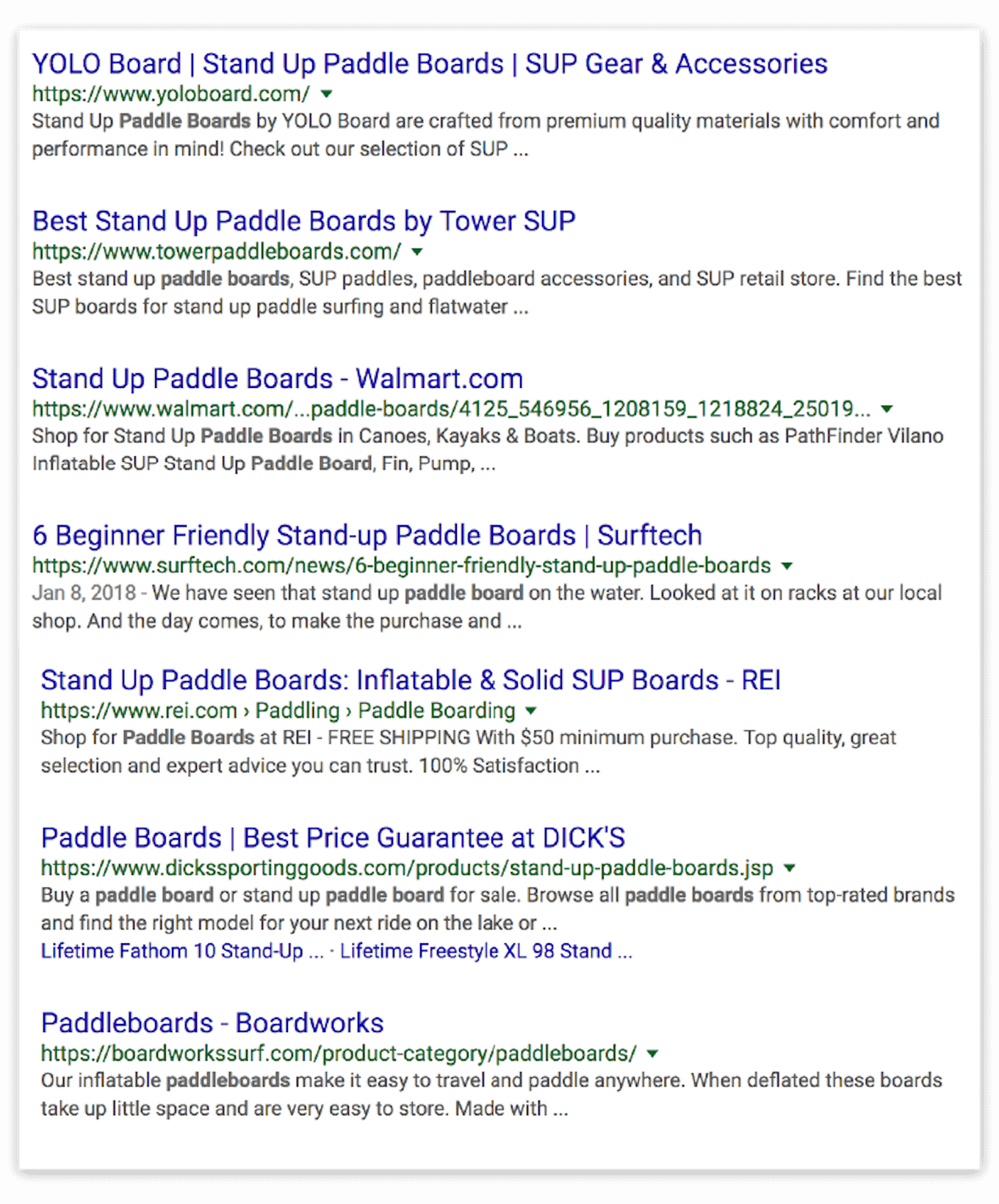
^Looking at the above list, the competitors that Isle Surf and SUP should focus on are YOLO Boards, Tower, Boardworks, Walmart, REI, and DICKs.
Before we move on, you might be wondering…
“Why Walmart, REI, and DICK’s? Those are HUGE retailers!”
Even though Isle Surf and SUP is a much smaller retailer, they are selling the same product – paddleboards – as Walmart, REI, and DICKs. So Isle Surf and SUP should also include them in their competitor analysis.
And now that we have Isle Surf and SUP’s list of competitors*…
*There are probably MANY more competitors for Isle Surf and SUP – but for the sake of getting you through this example faster…I kept it to seven.
Step 2: Research Isle Surf and SUP’s Competitors
Pick one of the listed competitors to research
For the sake of the example, we are going to research just one of the listed competitors (Boardworks), and then you would just repeat the same process for each competitor.
First, let’s jump into researching the business side of Boardworks and find answers to these three questions:
- How does Boardworks pricing model compare to Isle Surf and SUP?
- What type of retailer is Boardworks compared to Isle Surf and SUP?
- What is included in Boardworks product line compared to Isle Surf and SUP?
In this stage, it was easy to find all the information by visiting Boardworks and Isle Surf and SUP’s product pages on their website, and here’s a breakdown of the business side of Boardworks vs Isle Surf and SUP via infographic:
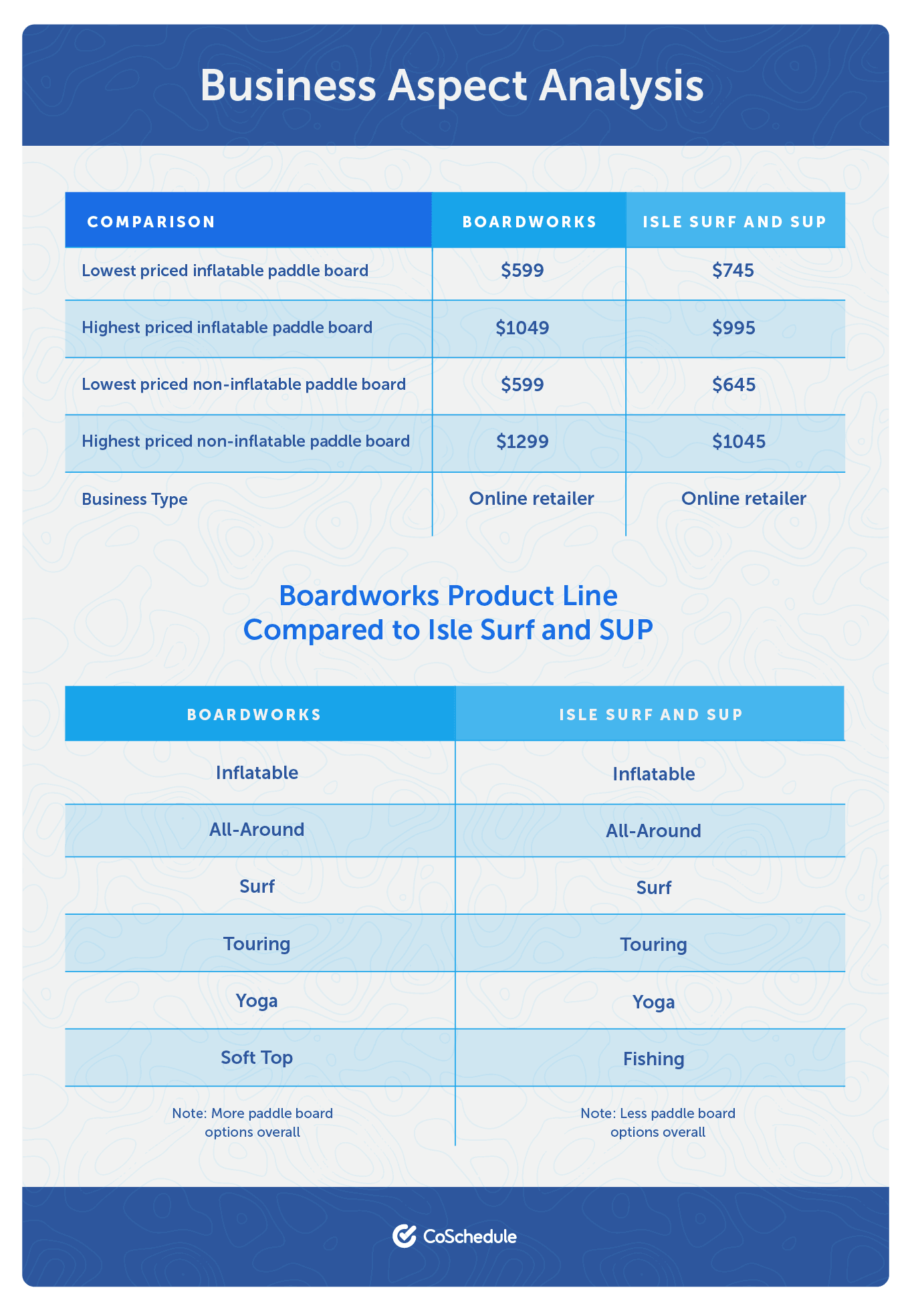
Next, we need to figure out why a customer would go with Isle Surf and SUP versus Boardworks (and vice versa).
The best way for Isle Surf and SUP to gather competitor insights is by emailing a survey to new and current customers—especially those who just bought a paddleboard. A simple link in a thank-you email (separate from the order confirmation) makes it easy.
Here’s an example of the email:

And an example of how the survey could look:
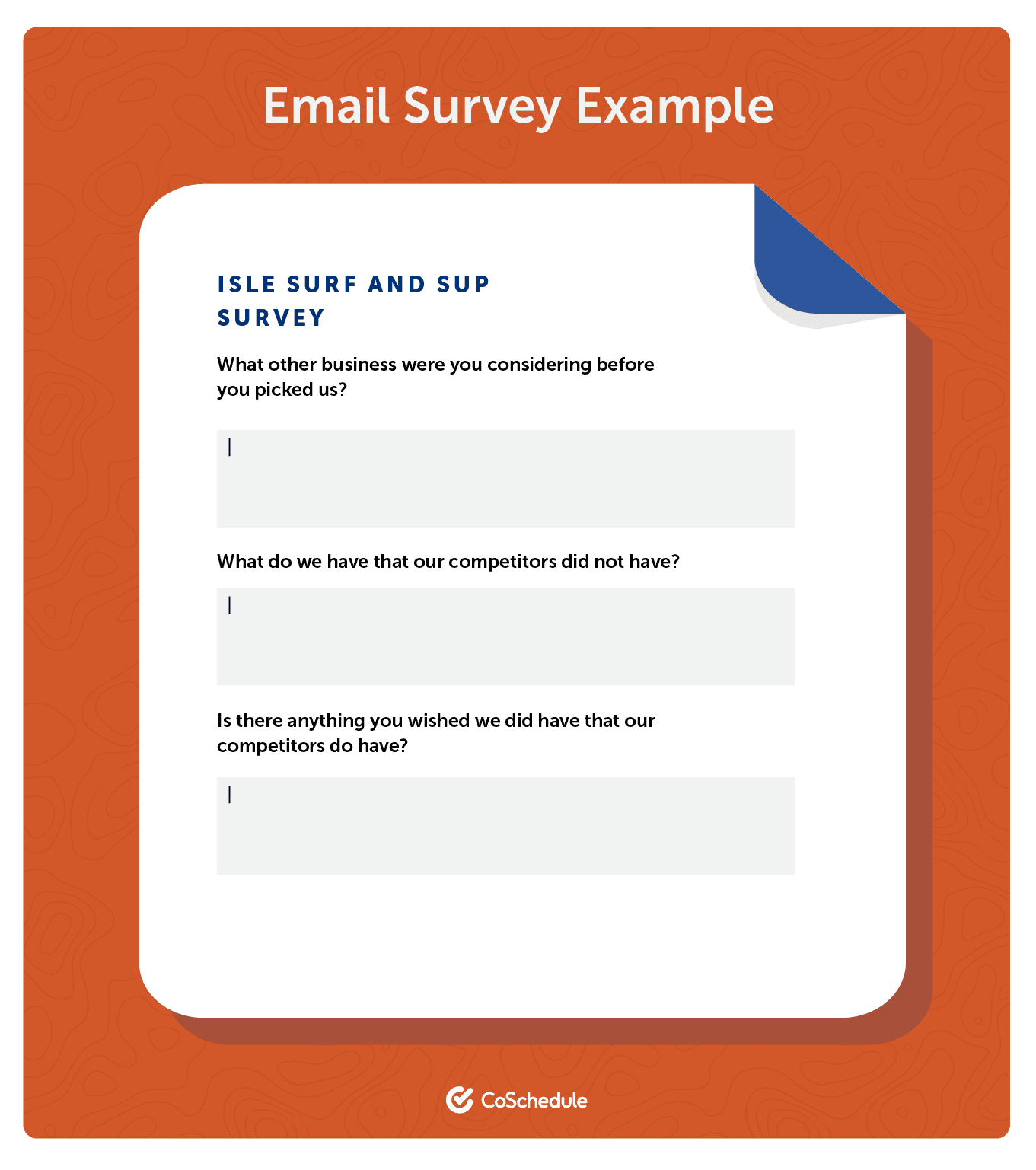
A key to a great survey?
Use a mix of open-ended and multiple-choice questions. This ensures you get the answers you need, plus long-form answers written by customers (which are great for Isle Surf and SUPs marketing team to use when they are writing marketing copy).
Finally, let’s get all the marketing deets we can on Boardworks.
As a refresher, here are the major things that Isle Surf and SUP should consider:
- What is Boardworks doing with their marketing content?
- What are there overall strategies when it comes to demand generation, PR / social media, and product marketing for Boardworks?
- Who is Boardwork’s target audience?
- How many followers do they have on all the social networks?
- How are they positioning themselves in the market?
Based on my research throughout Boardworks (and Isle Surf and SUP) website, here is a breakdown (via infographic) of the differences between their marketing strategies:

And voila!
Let’s move onto the final step!
Step 3: Compare Isle Surf and SUP With Boardworks
AKA…time to perform the SWOT analysis!
Here’s a nice visual of how this would look:
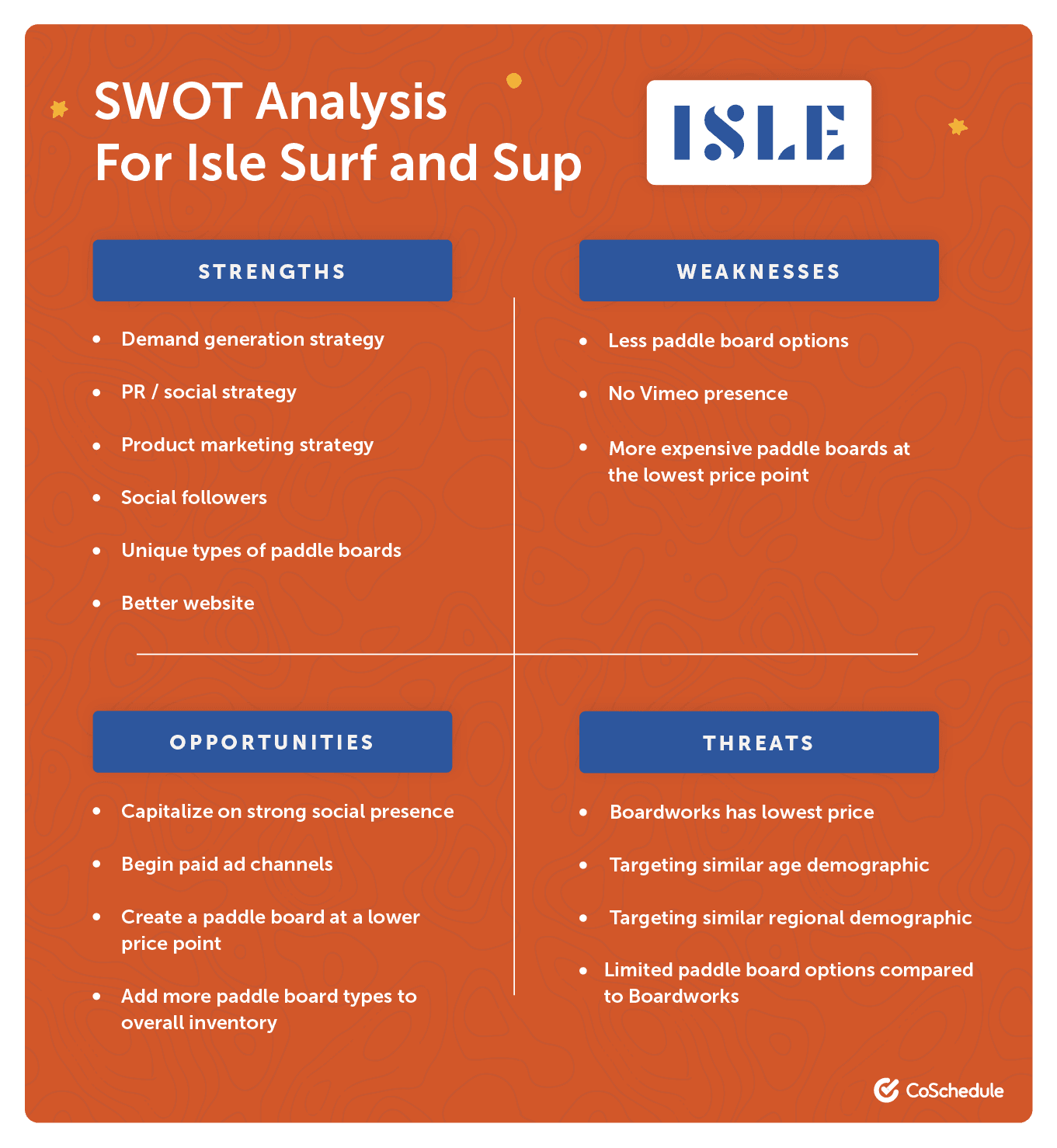
^The most important part of the SWOT analysis is how you use the information you learn from it…
So in this case, it looks like Isle Surf and SUP should capitalize on their main strengths, their website and overall marketing strategy, since both are far superior from Boardworks’…but it also looks like (based on their threats) that they should consider making adjustments on pricing and potentially their target demographic (depending on their overall market strategy) – or Boardworks might be able to close the gap on market share.
Once Isle Surf and SUP completes their competitor research, they’ll have a clear picture of where they stand and what changes to make. Just like that, their analysis is done—until next time (which, cough, should be every few months to stay up to date).
Tools to Help You Perform a Competitor Analysis
Rival IQ
Rival IQ is a competitive analysis tool focused on social media insights. It allows you to track competitors’ social performance side by side.
It provides key metrics such as follower growth, posting frequency, engagement rates, and top-performing content—all from one place.
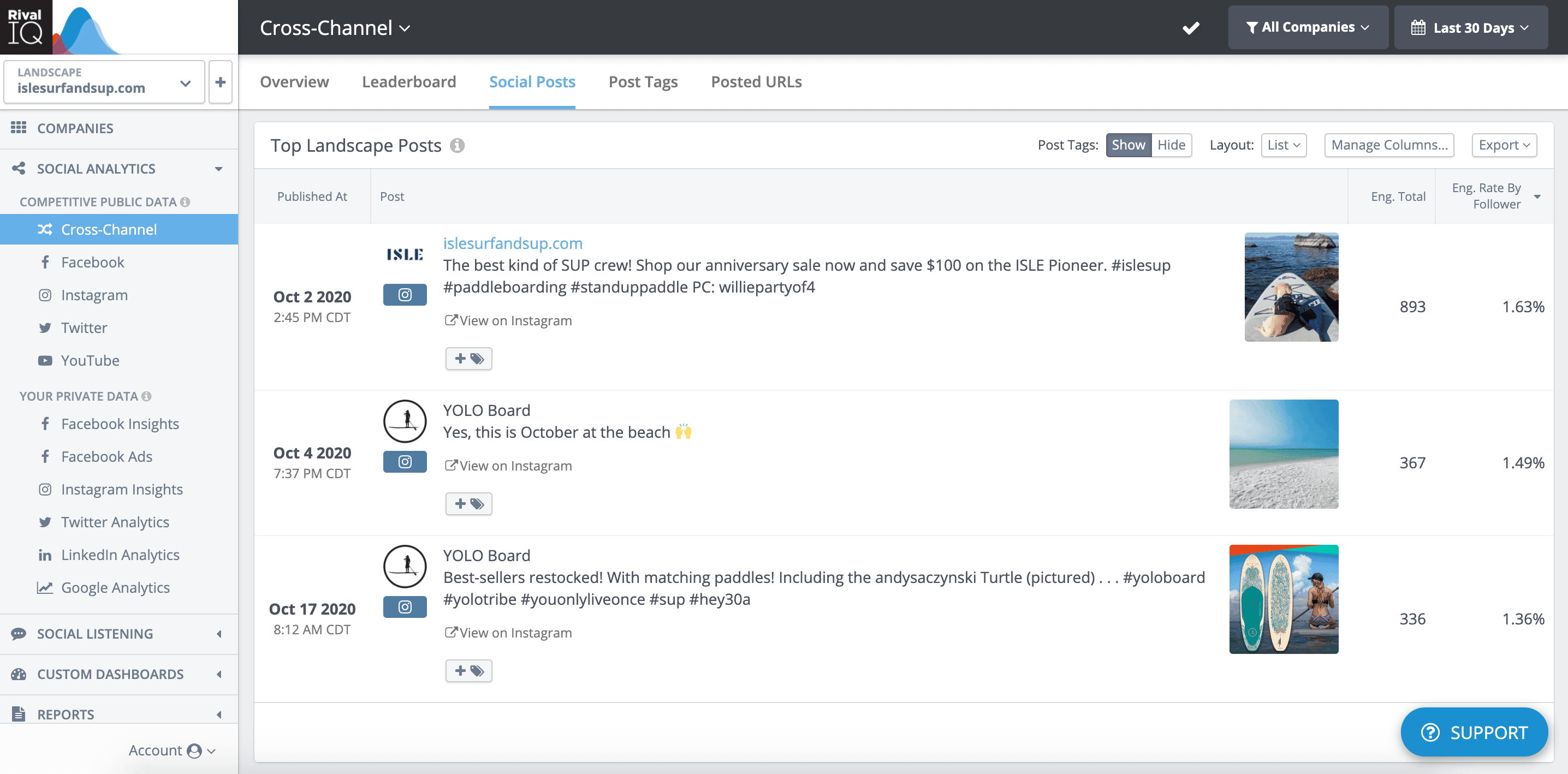
Buzzsumo
Buzzsumo gives you key insights about your competitors. For instance, you can easily see what content marketing activities are gaining the most traction, which influencers are sharing their content and what channels are most successful for them.
Ahrefs
Ahrefs is one of the best competitive analysis tools for SEO. The site explorer tool allows you to check any URL’s top organic keywords. You can also check which of your competitor’s content is gaining the most backlinks.

Hire Mia
You can also utilize AI to help with your research, and Hire Mia’s Competitor Analysis Generator is a great place to start.
Here’s how to use the Competitor Analysis Generator effectively:
1. Enter Competitor Details
Fill in the names of the competitors you want to compare, along with key details like their industry, target audience, pricing, marketing strategies, and unique selling points. Also, note their strengths and weaknesses.

2. Generate Your Competitor Analysis
Click the button to create a structured report based on your input.

3. Review and Apply Insights
Analyze the generated report to identify trends, gaps, and opportunities that can help you refine your strategy.

4. Customize Your Results
You can ask again or adjust the tone, length, and structure of the result to fit your needs.

Perform Your Own Competitor Analysis
Now that you know what a competitive analysis is (and why you should care)…
How to conduct your own competitive analysis (in three easy steps)…
You’re equipped with an example of a competitor analysis (for easy reference later)
AND you have your very own competitor analysis template.
It’s time to get to it.

